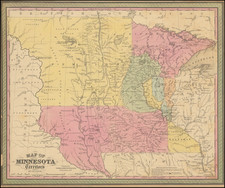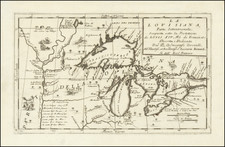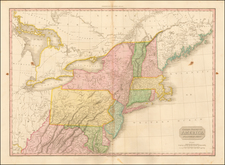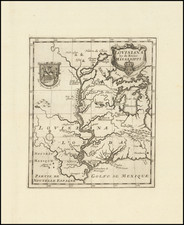Strking grand format birdseye view of St. Louis, Missouri, gateway to the West, published by America's most commerciall successful printseller, Currier & Ives.
St. Louis has one of the most faaciniaing histories of any American City. Founded in 1764, just south of the confluence of the Missouri and Mississippi rivers by colonial French traders Pierre Laclède and René Auguste Chouteau, the city is named after King Louis IX of France. The city, as well as the future state of Missouri, became part of the Spanish Empire after the French were defeated in the Seven Years' War. In 1800, the land was secretly transferred back to France, whose leader, Napoleon Bonaparte, sold it to the United States in 1803. Nicknamed the "Gateway to the West" for its role in the westward expansion of the United States, it served as a point of cultural transition point for generations, not for those seeking forrtunes and a life west of the Mississippi, but as the major north-south artery for American commerce.
In 1874, St. Louis found itself at a relative zenith of opportunity. The Golden Spike had been driven, East was finally connected with West, and St. Louis found itself at the center of a a wild period of growth and expansion, a launching point for fortune seekrers in the mineral mines of the west, the best natural port for overland commerce returning east, a cultural and economic centerpiece for the booming agricultural expansions then being promoted by the natioal railroads, eager to recoup their investments in westward expansion and truly at the centerpoint of America's hearltland.
Against this back drop, the original artwork for this fiew by Charles Parsons and Lyman Atwater provides a remarkable depiction of this uniquely American city. Their work shows in fine detail the spread of St Louis, its growth along the River and its seemingly limitless potential. Ironically, the view foreshadows the production of the single greatest view, published the following year, Camille N. Dry's 1 875 Pictorial St. Louis; The Great Metropolis of the Mississippi Valley, which was dedicated to the famous Mississippi River bridgebuilder Capt. James B. Eads. It was produced on 110 plates, which when trimmed and assembled created a panorama of the city measuring about 9 by 24 feet. Dry issued the panoramic map in an atlas, the preface of which included the following notes regarding its preparation:
A careful perspective, which required a surface of three hundred square feet, was then erected from a correct survey of the city, extending northward from Arsenal Island to the Water Works, a distance of about ten miles, on the river front; and from the Insane Asylum on the southwest to the Cemeteries on the northwest. Every foot of the vast territory within these limits has been carefully examined and topographically drawn in perspective . . . and the faithfulness and accuracy with which this work has been done an examination of the pages will attest.
The St. Louis panorama evidently was prepared to show the city's progress at the United States Centennial celebration of 1876. The verso of each plate contains information on various aspects of St. Louis economic life, including businesses, professions, schools, churches, and governmental organizations. Every building in the area was drawn on the map, and 1,999 specific sites were identified by name. A note in the preface requests that any mistakes detected be looked upon with a lenient eye by an indulgent public "in view of the magnitude of the work, the originality of the idea, and the difficulties encountered in carrying it out." Dry's map of St. Louis is a magnificent extension of the normal single-sheet lithographic view and one of the crowning achievements of the art.
Because Birdseye Views were essentailly ephemeral in nature (promotional items intended to capture a snapshot of a place at one particular point in time) and not issued in bound volumes, the survival rate is relatively low, especially examples which were colorized at the time and displayed publically. Unlike maps and views bound into atlases, these views were largely gone withing a few years of their original publication.
As a medium of expression, the view would later give way to the panoramic photograph and later aerial phtograph, making these grand panoramic lithographs the final link between the Italian landscape painters of the 14th and 15th Centuries, the great town books of Braun & Hogenberg, the multi-sheet works of the great 17th and 18th Century European City illustrators, and the American tradition of promoting cities, large and small, with idealized images.
While Currier & Ives prints are by no means rare, the survival rate of their great large format city views is surprisingly small and views such as this one can now be considered rare on the market. The present example was acquired at a German Auction house in late 2009 and is generally reflective of the wide spread interest, especially in Germany, in th growth of the US and commerce opportunities not then available in Europe.









![[ Southern Railroads ] Railroad Map of the Southern States Shewing the Southern & Southwestern Railway Connections With Philadelphia. 1862 . . . Prepared by Thomas Kimber Jr., Chairman of the Committee on Inland Transportation of the Board of Trade of Philadelphia](https://storage.googleapis.com/raremaps/img/small/103211.jpg)


![Comparative Size of Lakes and Islands [Great Lakes, Cuba, Formosa, Ireland, Sicily, Cyprus, Vancouver, Sandwich Islands, Puerto Rico, Corsica, Sardinia, Balearics, Malta, etc]](https://storage.googleapis.com/raremaps/img/small/92574.jpg)

